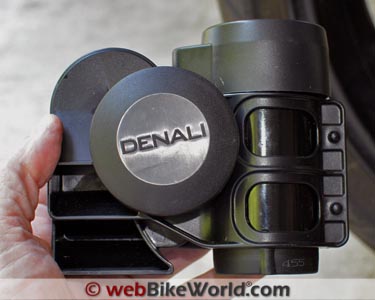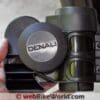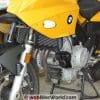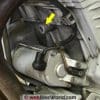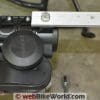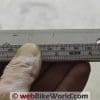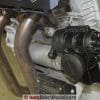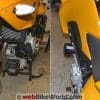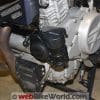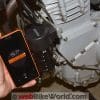The Denali “Soundbomb” horn delivers the goods, with a 118 dB (measured) high-pitched tone.
It looks very similar to the Stebel Nautilus Compact horn (review).
In fact, we wouldn’t be surprised to learn that the Soundbomb is made by Stebel or by ex-Stebel designers.
That resemblance also means that this is a very large horn. It can be very difficult to fit on some/many motorcycles.
However, Twisted Throttle (the Soundbomb distributor/retailer) sells accessory mounting kits for some motorcycles.
But, we had to come up with our own custom mount for a BMW F 800 S, just to show it can be done with some ingenuity.
We have published many motorcycle horn reviews over the years; a loud replacement horn is usually one of the first additions to a new project bike.
Original equipment motorcycle horns are notoriously awful, with a wimpy “meeep-meeep” type being way too common.
Motorcycle manufacturers should definitely be doing better, or they should at least sell an accessory horn that has some guts.
If they did, we guarantee that just about every owner would go for the option, adding to manufacturers’ and retailers’ profits. Currently, the manufacturers are leaving money on the table.
Referring back to our motorcycle horn reviews and the big horn comparison review we did back in 2008 (was it really that long ago?), there just haven’t been any new horns released since that date, thus the comparison is still valid.
In fact, the Denali Soundbomb horn may be the only new horn to have been developed and released since then, which shows how slowly the horn industry (is there such a thing?) moves.
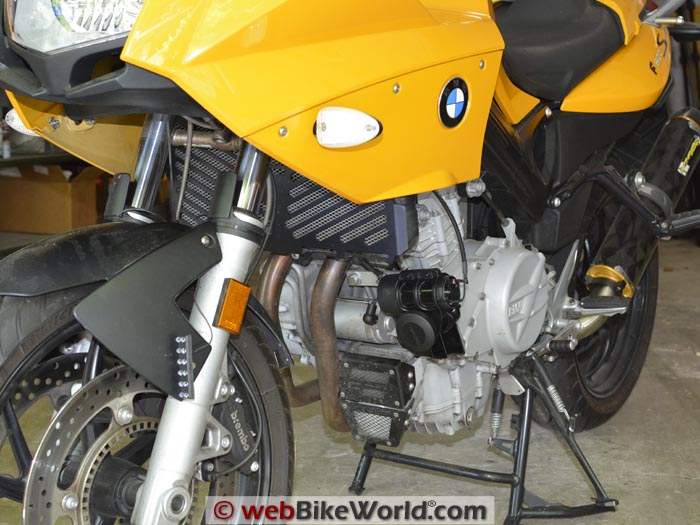
Soundbomb vs. Nautilus
Some motorcycle owners have opted for the huge Stebel Nautilus Max (review) or more likely, the Stebel Nautilus Compact (review) as their replacement horn choice.
But our experience with the Nautilus horns has been, well, miserable, to say the least. You can read all about it in the above two reference reviews and, in fact, we purchased yet two more Stebel Nautilus Compact horns recently, which were originally intended for this review.
The first failed due to our fault — some melting damage due to our mounting experiments, while the second failed after the third short beep, just like the other Nautilus horns we have tried over the years.
All of the Nautilus horns were mounted using a high-quality relay harness and each horn failed almost immediately. You can hear the sound of a dead Nautilus in the linked .mp3 sound file library below.
There’s nothing like going through all the trouble of mounting a big Nautilus — no easy task — and having it fail before you get the bike out of the garage. Oh well…
So we quickly ordered one of the Denali Soundbomb horns to try and salvage our review efforts.
The Denali Soundbomb Horn
The Denali Soundbomb horn was made for Twisted Throttle as a replacement for the Stebel Nautilus Compact. Without getting into too much detail, we were told that TT needed to find a replacement for the Nautilus, for several reasons.
The Soundbomb (probably not the best name for a product here in our crazy 21st Century) looks nearly identical to the Nautilus Compact.
Twisted Throttle said the horn was designed to be more reliable than the Stebel version, while still providing a loud air horn sound.
Although the Soundbomb looks very similar to the Nautilus, the construction appears to have more plastic than the Nautilus. But, so far it has proven to be much more reliable than the Nautilus in our experience. In other words, it works.
One main difference is that the compressor on the Soundbomb is attached with a clamp with two bolts. On the Nautilus, the horn or trumpet section appears to be glued to the compressor.
The clamp is said to be more resistant to vibrations, which helps to improve overall reliability of the horn.
In all fairness, however, we never had a problem with the actual physical construction of the Nautilus horn; the electronics or internals just never worked correctly. The 5 horns that we purchased randomly over a several year period all failed almost immediately.
The Soundbomb horn used in this review is the single unit version. There’s also a version with a separate compressor canister that can be remotely mounted.
The Soundbomb horn has a hefty 20 Amp draw. It measures about 138 mm wide, 116 mm tall and it’s about 88 mm deep. It also comes with a relay, but as always, we used a pre-made horn relay wiring harness (review).
Sound Output
The Soundbomb horn is claimed to have a 120 dB output, measured at three feet away. As we have detailed in several horn reviews, however, accurately measuring the volume is highly variable.
But, using the Extech dB meter, we measured 118 dB at three feet for the Soundbomb, a good showing.
The horn has a higher pitch “European sports car” sound than the Stebel Nautilus horns or the Fiamm Freeway Blasters (review) or the Stebel Magnum horns (review) now mounted on the 2014 Suzuki V-Strom 1000 ABS (Blog), which sound like a loud car horn.
Denali Soundbomb .mp3
Here’s a quick Denali Soundbomb .mp3 file (opens in new window) with the sound of the most recent failed Nautilus, along with the sound of the Soundbomb horn.
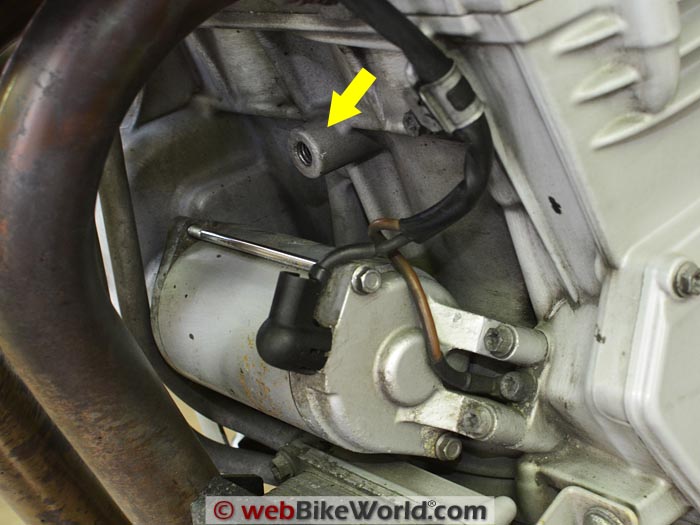
Mounting the Denali Soundbomb
The hardest part of dealing with the Nautilus or Soundbomb is mounting it on the motorcycle. These are big horns and most motorcycles have very limited spaces underneath the fairing or around the engine for mounting such a monster.
For best results, the Denali horn should really be mounted so that the dual trumpets point forward, not to the side. This complicates the process of finding a suitable mounting position, because it means the widest part of the horn must face forward.
Also, the trumpets must be located so that any water entering the openings will drain out.
The mounting problem is even more complicated because there’s just a single bolt location on the horn body that can be used for mounting. This is a cast metal cutout that fits the 8 mm hex head bolt that comes with the kit.
Twisted Throttle sells some mounting kits with brackets for various bikes and many of those mount the horn on the side of the bike, but for all other motorcycles, you’re on your own.
The two of us spent quite a bit of time trying to find a good location to mount the Soundbomb horn on the BMW F 800 S. We tried to mount the horn behind the fairing and also in front of the exhaust pipes, on the side of the engine and even towards the rear, but nothing worked.
Finally, we noticed a big threaded boss in the front of the engine, shown in the photo above. It is designed to hold a 10×1.5 mm bolt. Anyone know what this is for? Perhaps it’s used during engine assembly? There’s another, smaller threaded boss in back of the engine also.
The horn won’t fit behind the exhaust and you don’t want to get these plastic horns near the exhaust anyway (as we learned to our chagrin).
So we came up with the idea of using a thick piece of 3/8″ thick scrap aluminum bar about 150 mm long (purchased at a local hardware store) to offset the horn out towards the left-hand side of the engine.
Here’s a photo:
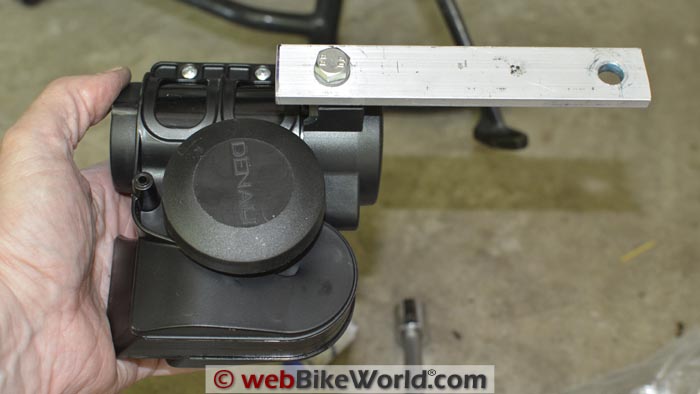
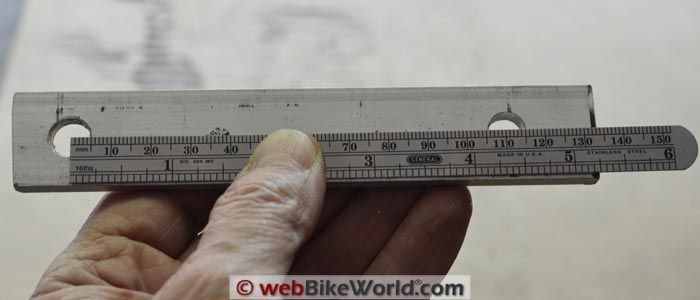
But a webBikeWorld visitor who read the instructions more carefully than us (!) wrote to let us know we made a mistake.
The instructions note that “the horn should be mounted so that the cylinder is vertical with the horn facing down. There should be no more than a 25 degree variance from the vertical position.”
So we cut a longer (18 cm) length of aluminum, drilled the two holes as noted below and re-installed the horn, this time in the correct orientation.
As you can see from the photos below, the new mounting position puts the horn in the correct orientation and actually works better than the original mounting, because the wires can be semi-hidden behind the horn body.]
We wanted to locate the horn far enough away from the exhaust but as close as possible to the engine. This wouldn’t work on the right side of the F 800 S, due to the exhaust location.
Another mounting concern is that the positive and negative wire terminals on the Soundbomb horn are located on one side, instead of being hidden along the back, which would make wire connections easier.
Here’s a photo of the original incorrect mounting orientation. The cylinder is horizontal and we confirmed with Twisted Throttle that this is incorrect and will cause the horn to fail:
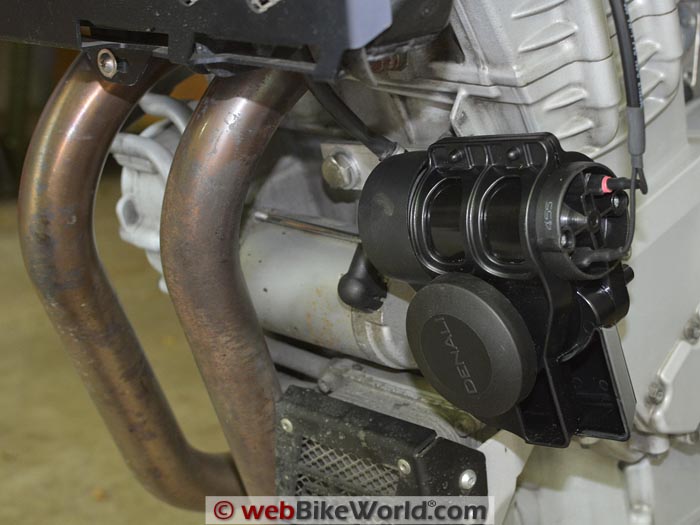
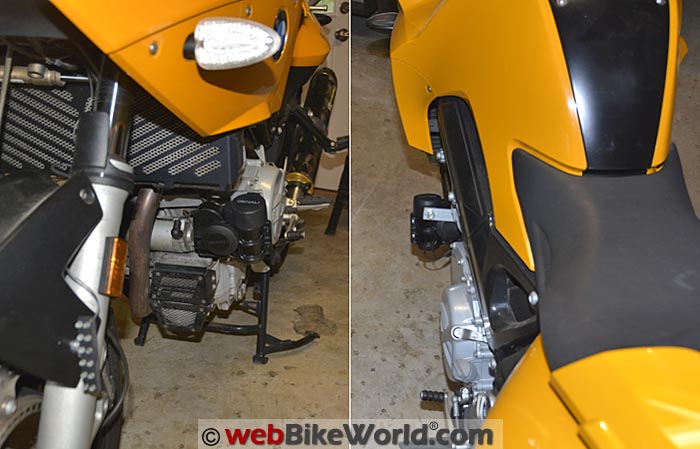
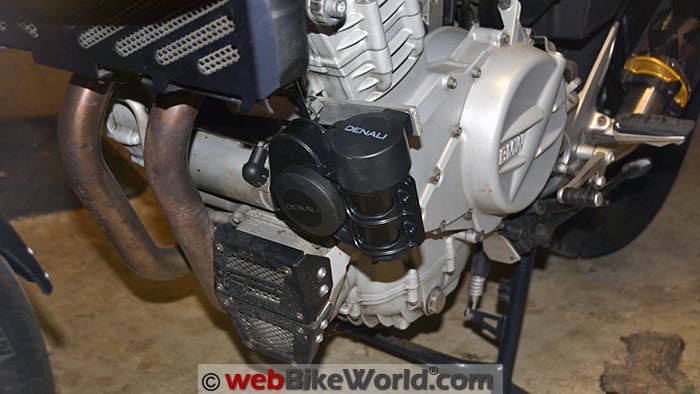
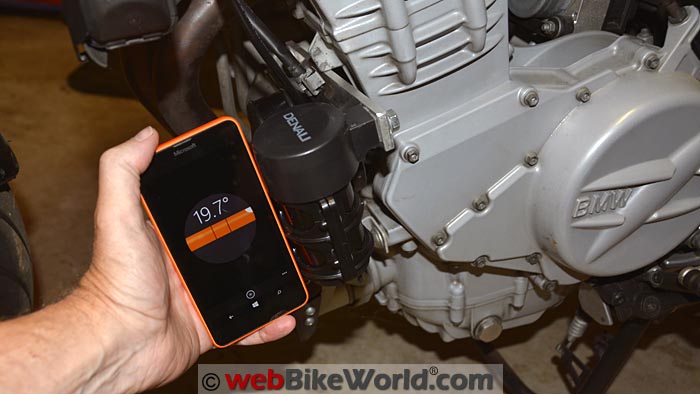
Connecting the Horn
Once we figured out a solution to the mounting problem on the BMW, the rest was easy.
A relay is included in the kit and you can wire it yourself, but a webBikeWorld reader clued us in to this dual horn wiring harness with relay kit for a dirt cheap $12.99. How anyone can make this harness for 13 bucks and still make a profit is a mystery!
Connect the positive and negative to the battery; connect one pair of wires to the horn and plug in a 20A fuse and you’re ready to go. On the F 800 S, the battery is under the black strip over what appears to be the fuel tank but isn’t.
Again, the only issue with our installation on the F 800 S is the wires sticking out the side. Too bad the horn connection wasn’t centrally located at the rear of the horn…
Conclusion
The Denali Soundbomb is a nearly identical replacement for the old Stebel Nautilus Compact, but the Denali version works. We had zero luck with the Stebel Nautilus horns after trying several over a multi-year time span.
The Denali horn is very loud, with a piercing tone that should get all the attention you need.
Don’t forget, a horn is a last resort tool. You should always ride a motorcycle defensively — as if you were invisible. Don’t count on using a horn to get vehicles to move out of your way.
Mounting the very large Denali Soundbomb horn can be a challenge if you don’t own a motorcycle that has one of the accessory mounting kits available.
But if you can figure something out, we’d have to say that the Denali Soundbomb is about the loudest and most attention-getting horn you can put on a motorcycle.
Owner Comments and Feedback
See details on submitting comments.
From “Q” (September 2015): “Thank you for the review. I looked at the link for the harness you mention….based on reviews, I won’t buy it. Seems like you are getting your moneys worth. Twisted seems to have a decent price on their harness with good reviews.”
Rick’s Reply: Works perfect for us, in fact, I bought 4 of them to use on other bikes. Super quality, don’t know how the guy does it for the price.
From “E.Z.” (August 2015): “I have a working Stebel Nautilus Compact on my NT700VA. It sounds exactly like the Denali on your .mp3 file!
Incidentally, I had a shop install the Stebel, and it sounded terrible. They gave me back my wiring kit, so I wondered what it would sound like with the wiring kit installed.
When I opened up the fairing, I saw that the tech connected the horn directly to the OEM horn wiring. When I installed the wiring kit, voila! It worked like a charm. So much for professional installation!
I have Clearwater Glenda lights (review) on my bike, and with a little wiring, soldering, and Clearwater’s instructions, the Glendas go to maximum power if the horn is hit. A nice feature which is standard on the larger Clearwater lights, but not the Glendas.
As always, your website is the best.”
From “K.S.” (July 2015): “Thanks for your reviews. I always appreciate the advice.
The first replacement part on any bike I own is the horn. And I always install an air horn. I have owned this Denali horn, installed on an Aprilia 850 V-twin, for about a year now.
It is mounted to the frame in a location similar to your example, and in the original horn location. It has worked without fail. Connections have been checked periodically for vibration, and no issues found. I highly recommend it.
Twisted Throttle also sells a wiring harness for it and various length/configuration coated steel attachment parts. I acquired all the kit I needed from TT, and the install went smoothly.
Aside: I previously installed a Stebel Compact horn on another bike — inside a fairing, above the front fork (less vibration and moisture as a result). It worked fine for the five years I had that bike.”


